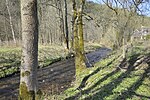Jonastal (Jonas Valley), situated in the Ilm-Kreis district in Germany between Crawinkel and Arnstadt and near to the town of Ohrdruf, was a scene of military construction under the National Socialist regime during the last years of the Second World War. Thousands of prisoners from the Buchenwald concentration camp under the command of SS General Hans Kammler were forced to dig 25 tunnels into the surrounding mountain and the whole operation was performed under the strictest secrecy. The site was not completed and construction was abandoned before the end of the war.
The exact aim of the operation remains uncertain although it is now believed to have been either a potential final headquarters for the führer Adolf Hitler, a military communications post or a possible center for V-2 rocket and Wunderwaffe weapon production and research. The latter is given some credence by the fact that SS General Hans Kammler was in overall charge of the construction efforts.
Ohrdruf, its forced labour camp and the nearby Jonas Valley were captured by American troops on April 4, 1945, by the 4th Armored Division and the 89th Infantry Division. The camp was the first Nazi concentration camp liberated by the U.S. Army.At the end of the war, the Soviet Army, which took over the site from the Americans, immediately classified it as a restricted zone and then used it as a military training ground. After the fall of the Berlin Wall, the site was taken over by the German armed forces who continue to use the area.






